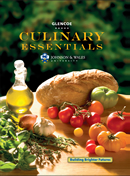
Culinary Essentials ©2010Chapter 23: Meat CookeryCheck Your Answers: After You ReadSection 23.1Review Key Concepts1. Barding is wrapping lean meat with fat. It provides an alternate layer of fat to keep the meat moist, tender, juicy, and flavorful. Larding is inserting long, thin strips of fat or vegetables into the center of lean meat. This adds moisture, flavor, and visual appeal to the meat.2. When purchasing meat, things to consider include: the menu, the cooking methods to be used, the price, and the quality and value. Practice Culinary Academics3. English Language Arts Student guides should be thorough, using all information from the chapter to create a well-organized and informative guide that would be helpful to a new employee who needs to purchase meats.4. Social Studies There are many examples of dishes made from offal or the tougher cuts of meat that are not purchased often in our society, such as hearts, brains, and bone marrow. Students should research one such dish and create a visual presentation to show the recipe and the meat cut it uses. 5. Mathematics The pounded cutlets are 3/16, or 18.75%, of the original thickness. The new thickness of the veal cutlets is (√8 inches) / (2/3 inches) of the original thickness. This expression is the same as dividing √8 by 2/3, which can be done by multiplying √8 by the reciprocal of 2/3, or 3/2. Thus, √8 × 2/3 = 3/16. Convert 3/16 into a percentage by dividing: 3 ÷ 16 = 0.1875 = 18.75%. Section 23.2Review Key Concepts1. Pork can be cured, aged, and smoked. Curing the pork is preserving the pork with salt, sugar, spices, flavoring, and nitrites. Smoking the pork is exposing the pork to the smoke of a fragrant hardwood after aging and curing.2. The primal cuts of lamb are the shoulder, the shank/breast, the rack, the loin, and the leg. 3. The primal cuts of veal are the shoulder, the shank/breast, the rack, the loin, and the leg. 4. The chuck is a cut of beef that comes from the shoulder. It contains part of the backbone, rib bones, blade bones, and arm bones. Practice Culinary Academics5. Mathematics There are 8 ounces of steak uneaten. In the first 2 hours, customers fail to eat 1 - ½ = ½ of the steak. In the next 2 hours, they fail to eat 1 - 2/3 = √3 of the remaining meat. In the final 2 hours, they fail to eat 1 - √3 = 2/3 of the remaining steak. Overall, they leave ½ × √3 × 2/3 = 2/18 = √9 of the steak uneaten. This equates to √9 × 72 ounces = 72/9 = 8 ounces of the steak remaining.Section 23.3Review Key Concepts1. Doneness is determined by internal temperature and color. Pork should be cooked to an internal temperature of 145°F (63°C) for 15 seconds. Steaks/chops should be cooked to an internal temperature of 145°F (63°C) for 15 seconds. Ground beef should be cooked to an internal temperature of 155°F (68°C) and held at that temperature for 15 seconds.Practice Culinary Academics2. English Language Arts The cooking guides should be creative, well organized, and visually appealing. They should reflect the information from the lesson about cooking meat. Additionally, they should combine written instructions with illustrations.3. Social Studies Sous vide was originally developed for cooking on trains and airplanes, but many professional chefs have picked it up because of the way it preserves the quality of the meat. Bacteria that produce botulism can grow in the absence of oxygen, so food safety is very important with this method. Special equipment has been developed to cook this way safely. Some health departments require a special variance or permit to use sous vide cooking. 4. Science What students are witnessing is the Maillard reactions. The amino acids react with the sugar in the corn syrup and the flavor, smell, and color change. 5. Mathematics Marco should cook the pork to 62.8°C. 70°C (158°F) is enough for the hamburger, which must be cooked to 155°F. For the pork, using the F to C formula results in C = (145° − 32) × 5/9, or C = 113 × 5/9, or C = 565 / 9 ≈ 62.8. For the hamburger, using the C to F formula results in F = (9 / 5 × 70°) + 32, or F = (630 / 5) + 32, or F = 126 + 32 = 158. |  |















